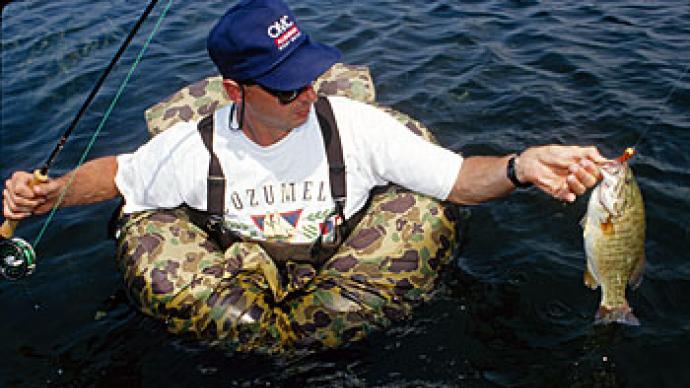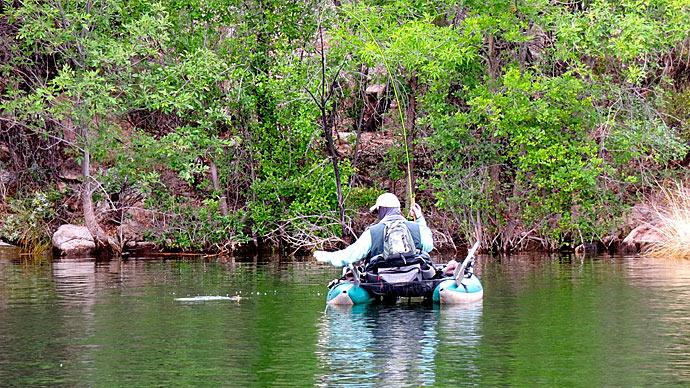
Float tubes are some of the most overlooked weapons in the bass fishing arsenal. Even though they aren't as streamlined, expensive or glittery as bass boats, float tubes can be used just as effectively to catch fish, and they are a blast to use. Trout anglers have seen the advantage of float tube fishing for years, but for some reason, bass anglers seem to shy away from these "belly" boats. Well guys, it's time to change the trend.
For those of you who aren't adventurous, don't read any further because I am about to take the role of your "float tubing buddy," and explain float tubing from the water up.
First, let's dispell any rumors that float tubes are unsafe. You may have heard the story of the guy who was fishing from his tube, capsized, and almost drowned trying to get himself out. Experiences like that are not very common and many involve other factors such as weather or current. In fact, I have fished my tube in very rough water, and not once have I been worried about sinking or capsizing.
By following a few simple rules, like never tubing alone, or in a current, staying close to shore and monitoring weather conditions you can ensure your safety.
Another good idea is to wear bright clothing, that way you can be seen by other boaters. And if you feel like fishing after dark, it's a good idea and the law in some states, to have a flashlight, just in case you can't be seen by other boats. I've had to use a light to alert boaters to my presence a number of times.
Okay, now that we have the safety part out of the way, lets get into a tube. When purchasing a tube, be warned, there are many different styles and kinds to choose from. They range from doughnuts to triangles in shape, but really, the shape doesn't matter. It's just a matter of finding one that you are comfortable fishing from. U-boats are my favorite because they are easy to get in and out of and have less drag in the water than a traditional round tube.
Trout Traps provided us with the tubes we used for this article. They are sturdy, lightweight, reliable and are an excellent choice for beginners and pros alike.(800-831-6398)

We also took the Creek Company's SUB for a test drive (800-843-8454). It is a cross between a pontoon-style kickboat and a float tube. It's very sturdy, comfortable, and you sit up out of the water higher than a traditional float tube. The problem we had was staying awake at the wheel, (note the picture of our sleeping editor) it was quite comfortable.
Float tubes range in price from around $80 bucks, all the way up to $300. If you are looking for a cheap tube, just remember you get what you pay for. Be sure to look for a few important features.
The shell should be sturdy and at least double-stitched at the seams. You should also look at the weight capacity of the tube. Obviously, if I weigh 250 pounds, and my tube is only rated to 225 pounds, I'm placing myself at risk of sinking. Also, be sure that your tube has more than one air bladder. This is a safety feature designed to provide you with something to float on if your main tube were to deflate.

After purchasing the tube, you will probably want to invest in a good pair of chest waders. Neoprenes are excellent for most uses, however, if you are fishing in a hot climate and warm water, you might consider something lighter because neoprene tends to hold in body heat. The waders we used were provided by Hodgman and Red Ball. Both companies make great products. The Hodgmans had more features, but the Red Ball waders did an excellent job.
There are now a number of styles of waders made with lighter weight, "breathable" materials such as Gore-Tex that keep you cooler, but if you're fishing in colder water you'll need to wear something warm underneath, or you'll get cold.
The last thing you need to launch your tube is a good pair of fins. I really liked the fins that were provided by Trout Traps, but if you have an old pair of scuba fins kicking around, those work nicely. Now that you have your float tube, waders, flippers, and fishing pole (can't forget that) you are ready to take your tube for a test drive.
Upon dressing yourself in your new waders and Red Ball Waders flippers, you will notice that you look (and feel) like a big wingless duck and you will waddle like one too, so watch your step. It's easy to trip in those big fins. I prefer to pack my waders and flippers down to the shore before I put them on. Then I'll stuff my shoes into one of the pockets in my tube.
There are a couple of ways to enter your tube. If you have a round tube, step into it, grab the handles that are usually provided on the outside of the tube, and slowly back your way into the water. Once you are just over knee deep, you can sit down and the tube will support you. If you have a U-shaped tube, you can enter the same way, or remove the bar and mesh tray that go across the opening, place the tube in the water, and carefully back your way into the seat. When the water is just above your knees, sit down and replace the bar and tray in front of you.
To move around, begin kicking your legs as if pedaling a bicycle backwards. Turning can be a little bit trickier, but generally comes naturally; just remember to use your fins, it's a whole lot easier than twisting your body from side to side.
Fishing from a float tube is a little bit different than fishing from the deck of a boat You don't have as broad a view of the water, nor do you have as much vertical space, so sight fishing and pitching become more difficult. You can, however, fish plastics, topwaters, spinnerbaits and you can flip from your float tube. Because you are sitting, you might notice that it's a little bit tougher to get a solid hookset. Don't get discouraged, you'll quickly learn how to improve your hookset, I recommend a sweep set.

Another thing that you will notice after hooking your first fish is that it will fight harder. Fishing from a lighter, lower, less-solid platform tends to give the fish a little more leverage. Even though the fish may not actually be fighting harder, it will seem like it. Just be careful, or you might get pulled into the stumps along with your monster bass.
There is a time and a place for every kind of fishing and every kind of boat. Using your float tube at the right times can add to its worth. At times, there are more people who want to fish than the boat will allow. This is a perfect time to use a float tube. By taking a couple of tubes along you can take two more people who would otherwise not have been able to fish.
On very hot days, you will stay cooler in your tube than on a boat because you're sitting in water. One of the best times to use your tube is when boats or wind have stirred up the waves a bit. It is a much smoother ride in a tube than on most bass boats, and you don't have to worry about steering the trolling motor.
Learning to float tube will expand your fishing experience. You don't need to buy a $30,000 dollar bass boat, or mortgage your house in order to have a good day on the water. For under $300 bucks you can get everything you need. Learn to float tube, and see what you've been missing.
Reprinted with permission from Bass West Magazine




